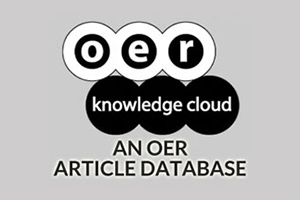Twenty-Five Years of the International Review of Research in Open and Distributed Learning: A Bibliometric Analysis
DOI:
https://doi.org/10.19173/irrodl.v26i2.8662Keywords:
bibliometrics, Scopus, open and distributed learning, Web of ScienceAbstract
The International Review of Research in Open and Distributed Learning (IRRODL) published its first issue in 2000. This paper provides an overview of the journal’s development over its 25-year history using bibliometric indicators. We analyzed IRRODL’s performance relative to other journals in the field and have highlighted key contributing countries, institutions, and authors based on the Scopus database. Our approach used various bibliometric techniques, including the number of articles and citations, cites per paper, and the h-index. The findings reveal that IRRODL is a leading journal in open and distributed learning, attracting a diverse group of authors from institutions and countries worldwide. Currently, Athabasca University is by far the most productive university, and the United States and Canada are the most productive countries appearing in the journal. However, the journal is very diverse with publications from all over the world.
References
Akturk, A. O. (2022). Thirty‐five years of the Journal of Computer Assisted Learning: A bibliometric overview. Journal of Computer Assisted Learning, 38(5), 1220–1253. https://doi.org/10.1111/jcal.12686
Alonso, S., Cabrerizo, F. J., Herrera-Viedma, E., & Herrera, F. (2009). h-index: A review focused on its variants, computation, and standardization for different scientific fields. Journal of Informetrics, 3(4), 273–289. https://doi.org/10.1016/j.joi.2009.04.001
Anderson, T., Cookson, P. S., Henderson, S., & McGreal, R. (2025). Twenty-five years of innovation and knowledge sharing: The legacy and future of the International Review of Research in Open and Distributed Learning. The International Review of Research in Open and Distributed Learning, 26(1), 1–15. https://doi.org/10.19173/irrodl.v26i1.8490
Arrow, K. J., Bernheim, B. D., Feldstein, M. S., McFadden, D. L., Poterba, J. M., & Solow, R. M. (2011). 100 years of the American Economic Review: The top 20 articles. American Economic Review, 101(1), 1–8. https://www.doi.org/10.1257/aer.101.1.1
Bar-llan, J. (2008). Informetrics at the beginning of the 21 century—A review. Journal of Informetrics, 2(1), 1–52. https://doi.org/10.1016/j.joi.2007.11.001
Bensman, S. J. (2007). Garfield and the impact factor. Annual Review of Information Science and Technology. 41(1) 93–155. https://doi.org/10.1002/aris.2007.1440410110
Bergstrom, C. T., West, J. D., & Wiseman, M. A. (2008). The Eigenfactor Metrics. Journal of Neuroscience, 28(45), 11433–11434. https://doi.org/10.1523/JNEUROSCI.0003-08.2008
Broadus, R. N. (1987). Toward a definition of “Bibliometrics.” Scientometrics, 12(5–6), 373–379. https://doi.org/10.1007/BF02016680
Chen, X., Zou, D., & Xie, H. (2020). Fifty years of British Journal of Educational Technology: A topic modeling based bibliometric perspective. British Journal of Educational Technology, 51(3), 692–708. https://doi.org/10.1111/bjet.12907
Cheng, B., Wang, M., Mørch, A. I., Chen, N. S., Kinshuk, & Spector, J. M. (2014). Research on e-learning in the workplace 2000–2012: A bibliometric analysis of the literature. Educational Research Review, 11, 56–72. https://doi.org/10.1016/j.edurev.2014.01.001
Clarivate. (2024). Journal citation reports. Clarivate. https://clarivate.com/academia-government/scientific-and-academic-research/research-funding-analytics/journal-citation-reports/
Cole, F. J., & Eales, N. B. (1917). The history of comparative anatomy: Part 1 – A statistical analysis of the literature. Science Progress, 11(44), 578–596. https://www.jstor.org/stable/43426882
Ding, Y., Rousseau, R., & Wolfram, D. (Eds.). (2014). Measuring scholarly impact: Methods and practice. Springer Nature. https://link.springer.com/book/10.1007/978-3-319-10377-8
Donthu, N., Kumar, S., Mukherjee, D., Pandey, N., & Lim, W. M. (2021). How to conduct a bibliometric analysis: An overview and guidelines. Journal of Business Research, 133, 285–296. https://doi.org/10.1016/j.jbusres.2021.04.070
Durak, G., Çankaya, S., & Can, S. (2024). Artificial intelligence in education: A bibliometric study on its role in transforming teaching and learning. The International Review of Research in Open and Distance Learning, 25(3), 219–244. https://doi.org/10.19173/irrodl.v25i3.7757
Durepos, G., Maclean, M., Alcadipani, R., & Cummings, S. (2020). Historical reflections at the intersection of past and future: Celebrating 50 years of Management Learning. Management Learning, 51(1), 3–16. https://doi.org/10.1177/1350507619879603
Figuerola-Wischke, A., Merigó, J. M., Gil-Lafuente, A. M., Kydland, F. E., & Amiguet, L. (2024). The Scandinavian Journal of Economics at 125: A bibliometric overview. The Scandinavian Journal of Economics, 126(4), 643–697. https://doi.org/10.1111/sjoe.12582
Garfield, E. (1955). Citation indexes for science: A new dimension in documentation through association of ideas. Science, 122(3159), 108–111. https://www.doi.org/10.1126/science.122.3159.108
Glanzel, W., Moed, H. F., Schmoch, U., & Thelwall, M. (2019). Springer handbook of science and technology indicators. Springer Nature. https://link.springer.com/book/10.1007/978-3-030-02511-3
Hallinger, P. (2023). An empirical reflection on Educational Administration Quarterly’s distinctive contributions to the field, 1965–2020. Educational Administration Quarterly, 59(5), 884–913. https://doi.org/10.1177/0013161X231200883
Hirsch, J. E. (2005). An index to quantify an individual’s scientific research output. Proceedings of the National Academy of Sciences of the United States of America, 102(46), 16569–16572. https://doi.org/10.1073/pnas.0507655102
Hussain, W., Merigó, J. M., Rahimi, I., & Lev, B. (2025). Half a century of Omega—The International Journal of Management Science: A bibliometric analysis. Omega-International Journal of Management Science, 133, Article 103226. https://doi.org/10.1016/j.omega.2024.103226
Jordan, K. (2014). Initial trends in enrolment and completion of massive open online courses. The International Review of Research in Open and Distributed Learning, 15(1). https://doi.org/10.19173/irrodl.v15i1.1651
Liyanagunawardena, T. R., Adams, A. A., & Williams, S. A. (2013). MOOCs: A systematic study of the published literature 2008–2012. The International Review of Research in Open and Distributed Learning, 14(3), 202–227. https://doi.org/10.19173/irrodl.v14i3.1455
Merigó, J. M., Cancino, C., Coronado, F., & Urbano, D. (2016). Academic research in innovation: A country analysis. Scientometrics, 108, 559–593. https://doi.org/10.1007/s11192-016-1984-4
Monastersky, R., & Van Noorden, R. (2019). 150 years of Nature: A data graphic charts our evolution. Nature, 575(7781), 22–23. https://doi.org/10.1038/d41586-019-03305-w
Podsakoff, P. M., MacKenzie, S. B., Podsakoff, N. P., & Bachrach, D. G. (2008). Scholarly influence in the field of management: A bibliometric analysis of the determinants of university and author impact in the management literature in the past quarter century. Journal of Management, 34(4), 641–720. https://doi.org/10.1177/0149206308319533
Pritchard, A. (1969). Statistical bibliography or bibliometrics? Journal of Documentation, 25, 348–349.
Rialp, A., Merigó, J. M., Cancino, C. A., & Urbano, D. (2019). Twenty-five years (1992–2016) of the International Business Review: A bibliometric overview. International Business Review, 28(6), Article 101587. https://doi.org/10.1016/j.ibusrev.2019.101587
Rojas-Sánchez, M. A., Palos-Sánchez, P. R., & Folgado-Fernández, J. A. (2023). Systematic literature review and bibliometric analysis on virtual reality and education. Education and Information Technologies, 28, 155–192. https://doi.org/10.1007/s10639-022-11167-5
Rousseau, R. (2014). Forgotten founder of bibliometrics. Nature, 510, 218. https://doi.org/10.1038/510218e
Rovai, A. P. (2002). Building sense of community at a distance. The International Review of Research in Open and Distributed Learning, 3(1). https://doi.org/10.19173/irrodl.v3i1.79
Scopus. (2024). Scopus Database. https://www.scopus.com/
Tukey, J. W. (1977). Exploratory data analysis. Addison-Wesley.
Wilson, M. L. (2022). Topics, author profiles, and collaboration networks in the Journal of Research on Technology in Education: A bibliometric analysis of 20 years of research. Journal of Research on Technology in Education, 56(3), 291–313. https://doi.org/10.1080/15391523.2022.2134236
Zurita, G., Mulet-Forteza, C., Merigó, J. M., Lobos-Ossandon, V., & Ogata, H. (2022). A bibliometric overview of the IEEE Transactions on Learning Technologies. IEEE Transactions on Learning Technologies, 15(6), 656–672. https://www.doi.org/10.1109/TLT.2022.3204457
Published
How to Cite
Issue
Section
License

This work is licensed under a Creative Commons Attribution 4.0 International License.
This work is licensed under a Creative Commons Attribution 4.0 International License. The copyright for all content published in IRRODL remains with the authors.
This copyright agreement and usage license ensure that the article is distributed as widely as possible and can be included in any scientific or scholarly archive.
You are free to
- Share — copy and redistribute the material in any medium or format
- Adapt — remix, transform, and build upon the material for any purpose, even commercially.
The licensor cannot revoke these freedoms as long as you follow the license terms below:
- Attribution — You must give appropriate credit, provide a link to the license, and indicate if changes were made. You may do so in any reasonable manner, but not in any way that suggests the licensor endorses you or your use.
- No additional restrictions — You may not apply legal terms or technological measures that legally restrict others from doing anything the license permits.







